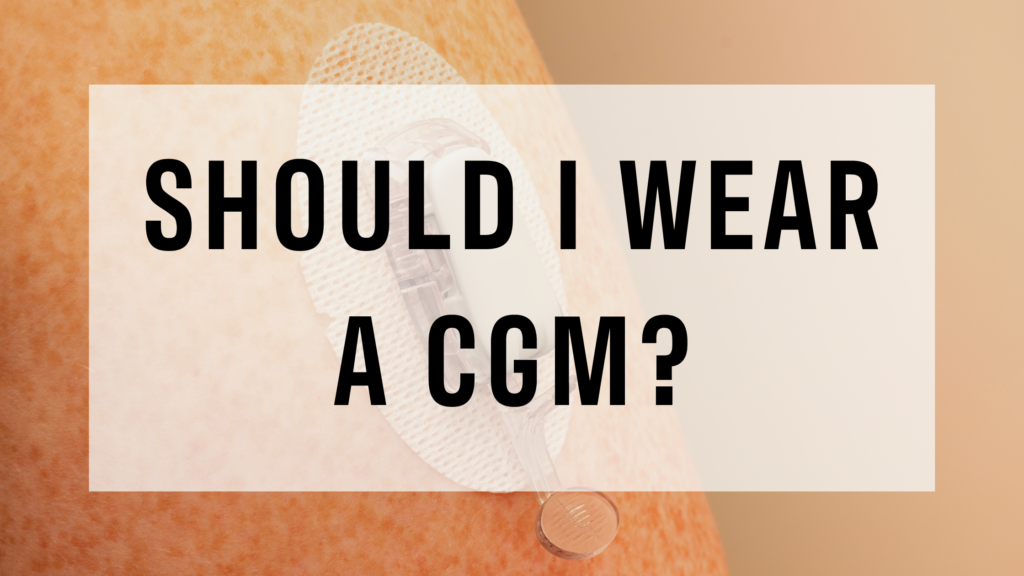
Should I Wear a CGM?

Continuous glucose monitors! A hot topic these days – and for good reason! They can provide such amazing insight as to what’s going on inside the body when it comes to blood sugar specifically. How does it respond to certain foods? To changes in sleep patterns? Alcohol? Exercise? The list goes on.
Now, do I recommend a CGM for everyone? No. I’ll explain why, but let me provide you with some more nerdy info on CGMs, how they work, and then who would and wouldn’t be a good candidate to take one for a test drive.
How do CGMs work?
The continuous glucose monitor is actually pretty new to our health technologies. The first company to introduce a model was Medtronic in 2004. Following a few years later in 2006 was Dexcom, and then Freestyle in 2008. If you have a family member with diabetes, you might be familiar with these companies!
So we’re not even talking 20 years that these nifty gadgets have been available to certain patients. One of the original intentions of the CGM was to help alert people with diabetes when their blood sugars were dangerously low or high, and they wouldn’t normally feel the symptoms on their own for some corrective action.
How do they work? Well, the monitor is placed either on the back of your arm in the tricep area OR somewhere in your mid-abdomen (depending on the brand). And no, the placement doesn’t hurt! They come with an applicator that guides a teeny tiny flexible eyelash-sized sensor through your skin so it can read your interstitial fluid. No needle stays in the skin!
This eyelash-type sensor is constantly reading your interstitial fluid, which glucose from the blood eventually travels here.
Most CGM sensors will remember your blood sugar every 5 minutes and store that data for review. Some sensors require you to scan the monitor a few times during the day or whenever you want to see your blood sugar. Others, like the Dexcom, automatically read your blood sugar and you can look at an app on your phone any time to see what it is.
How can you get a CGM?
For a while, CGMs were only available to patients with type 1 or type 2 diabetes. Doctors can write a prescription for their patients and insurance typically provides some sort of coverage (they also connect with insulin pumps now which is SO COOL).
Outside the diabetes world though, major interest has grown! The general population has caught on to how beneficial monitoring blood sugar trends is for our health (without having to do finger pricks!). So what if someone without diabetes wanted to get their hands on one?
Well, you can always have a conversation with your doctor. Some will not be open to you having one if you have no significant blood sugar concerns or family history of diabetes, especially if your A1c is in the normal range.
On the other hand, some may be open to writing you a prescription if you express a desire to support a healthy weight loss goal by learning how to keep your body in ideal blood glucose ranges. Some might be even more open if you have a significant amount of weight to lose.
If you have a prescription from your doctor, insurance coverage is really going to vary depending on the type of coverage you have and the diagnosis the prescription is tied to. You shouldn’t expect much coverage if you don’t have a prediabetes or diabetes diagnosis.
If you can’t get access to a CGM from your doctor, companies like Levels and Nutrisense make these devices available to everyone! Prices range depending on how many months you want to commit to, and they come with a dietitian and/or coach support.
You should wear a CGM if….
- If you know the foundations for blood sugar balance and have been consistently implementing them (which we teach you in Metabolism Makeover!)
- You’re ready to fine-tune your habits and lifestyle to support optimal blood sugar trends throughout the day.
- Numbers don’t stress you out. It’s just data to learn from.
You should NOT wear a CGM if….
- You have a history of tracking/monitoring calories or macros and it caused poor mental health, significant stress, or anxiety
- You haven’t learned the basics of blood sugar balance yet! Knowing your blood sugar trends throughout the day is cool, but if you don’t know how to tweak them or continue to support them, the numbers don’t mean a whole lot. This is exactly what our program Metabolism Makeover helps you learn: blood sugar balance to support fat loss. You can learn more about it here.
Is a CGM the key to weight loss or blood sugar balance?
No. You can absolutely lose weight successfully and balance your blood sugar without ever wearing a CGM.
Think of a CGM like a GPS in your car. Do you need a GPS to get to your familiar destination? Well, some of us who are directionally challenged really do (lol), …but my point is (in general), no. You can definitely use an old-fashioned map, listen to directions from someone, or go by the route you’ve learned before.
The GPS is just there to help guide you and perhaps decrease some mystery out of the situation if there’s traffic or an accident.
Similarly, a CGM can provide some great insight into how your body is responding to the meals you’re eating and how you’re living your life. A little less guessing.
I just really want you to understand that having the foundations in blood sugar balance is one of the best things you can do before you go down the rabbit hole of CGMs. They are really such a cool tool, but again, if you don’t have some foundational knowledge first, it could overwhelm you or leave you even more confused than when you started.
And remember, wearing a CGM is definitely trendy right now! Don’t feel pressured to run and get one if it’s not in the budget right now or you’re just getting started with better lifestyle choices. They aren’t going anywhere, so experiment with one when you’re ready or you feel it would be helpful!
Stay healthy,
Coach Elle

